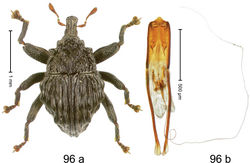Trigonopterus verrucosus
| Notice: | This page is derived from the original publication listed below, whose author(s) should always be credited. Further contributors may edit and improve the content of this page and, consequently, need to be credited as well (see page history). Any assessment of factual correctness requires a careful review of the original article as well as of subsequent contributions.
If you are uncertain whether your planned contribution is correct or not, we suggest that you use the associated discussion page instead of editing the page directly. This page should be cited as follows (rationale):
Citation formats to copy and paste
BibTeX: @article{Riedel2013ZooKeys280, RIS/ Endnote: TY - JOUR Wikipedia/ Citizendium: <ref name="Riedel2013ZooKeys280">{{Citation See also the citation download page at the journal. |
Ordo: Coleoptera
Familia: Curculionidae
Genus: Trigonopterus
Name
Trigonopterus verrucosus Riedel sp. n. – Wikispecies link – ZooBank link – Pensoft Profile
Diagnostic description
Holotype, male (Fig. 96a). Length 2.56 mm. Color black, antenna and tarsi ferruginous. Body subovate, extremely uneven, in dorsal aspect with distinct constriction between pronotum and elytron; in profile without such constriction. Rostrum in basal half medially carinate, coarsely punctate, sparsely setose; epistome with transverse, angulate ridge. Pronotum with marked subapical constriction; laterally projecting with marked angular protrusions; disk longitudinally costate-tuberculate, in basal half medially with prominent ridge. Elytra with striae deeply incised; intervals undulating-costate, some areas markedly elevated, constricted along 2 transverse lines, subglabrous, with sparse minute punctures and setae; apex extended ventrad, slightly beak-shaped, ventrally truncate. Metafemur with dorsoposterior edge simple, in apical third with transverse row of small suberect setae, subapically with stridulatory patch. Disk of abdominal ventrites 1–2 excavated; ventrite 2 projecting dentiform over elytral edge in profile. Aedeagus (Fig. 96b) with apex medially pointed; transfer apparatus complex, symmetrical; ductus ejaculatorius without bulbus. Intraspecific variation. Length 2.09–2.56 mm. Female rostrum dorsally with median costa in basal half; epistome simple.
Material examined
Holotype (MZB): ARC0743 (EMBL # HE615426), WEST NEW GUINEA, Jayawijaya Reg., Jiwika, Kurulu, S03°57.161', E138°57.357', 1875 m, 24-XI-2007, sifted. Paratypes (ARC, SMNK): WEST NEW GUINEA, Jayawijaya Reg. Jiwika, Kurulu: 1 ex (marked as ARC0612), 1900–2000 m, 23-IX-1992, sifted; 1 ex, ca. 1700–2300 m, 02-IX-1991, sifted.
Distribution
Jayawijaya Reg. (Jiwika). Elevation: 1875–1900 m.
Biology
Sifted from leaf litter in montane forest.
Etymology
This epithet is based on the Latin adjective verrucosus (full of warts) and refers to the species´ remarkable body-sculpture.
Notes
Trigonopterus verrucosus Riedel, sp. n. was coded as “Trigonopterus sp. 196” by Tänzler et al. (2012)[1].
Original Description
- Riedel, A; Sagata, K; Surbakti, S; Rene Tänzler, ; Michael Balke, ; 2013: One hundred and one new species of Trigonopterus weevils from New Guinea ZooKeys, 280: 1-150. doi
Other References
- ↑ Tänzler R, Sagata K, Surbakti S, Balke M, Riedel A (2012) DNA barcoding for community ecology - how to tackle a hyperdiverse, mostly undescribed Melanesian fauna. PLoS ONE 7 (1): e28832. doi: 10.1371/journal.pone.0028832
Images
|
